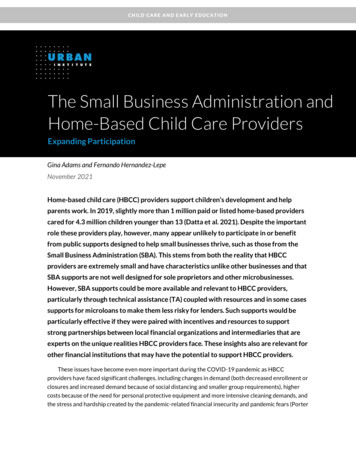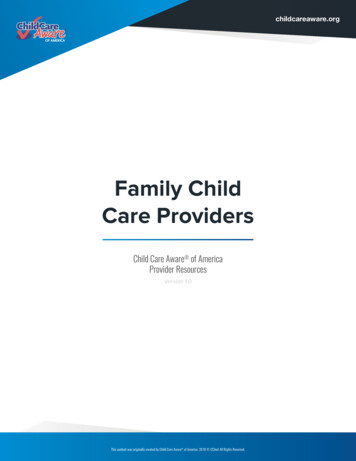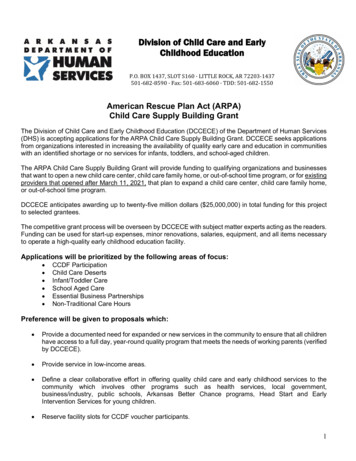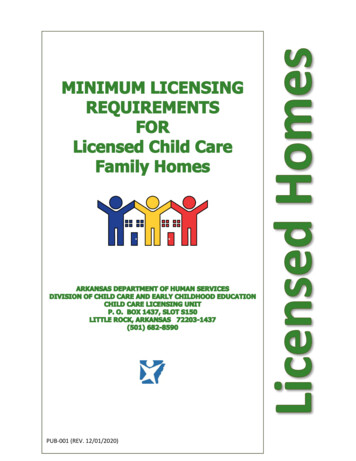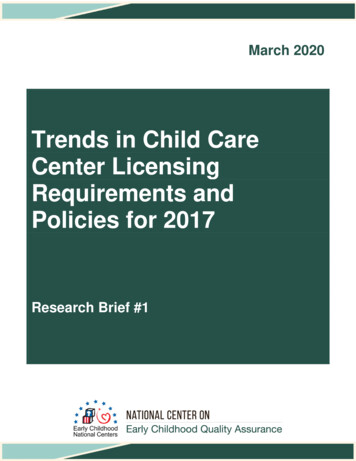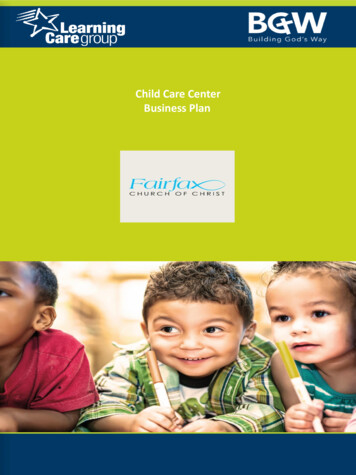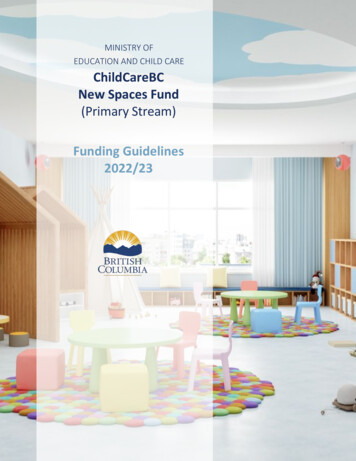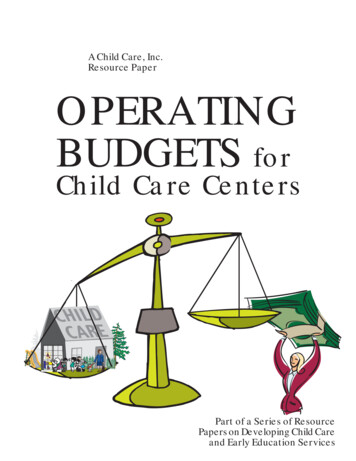
Transcription
Child Care in America:2014 State Fact Sheets
IntroductionThe Cost of Child CareChild Care Aware of America asked CCR&Rs forinformation about the average cost of child care inchild care centers and family child care homes forinfants, 4-year-old children and school-age children.The average annual cost of full-time care for aninfant in center-based care ranges from 5,496 inMississippi to 16,549 in Massachusetts. For an infantin a family child care home the cost ranges from 4,560 in Mississippi to 12,272 in Virginia.For the U.S. to participate fully in the 21st-centuryglobal economy, it needs to think of child care asequally a workforce support for parents and earlyeducation for young children. Child Care in America:2014 State Fact Sheets is critical for child careadvocates, policymakers and program administratorsas they make decisions about child care programsand expenditures. It provides the data to betterunderstand America’s working families and thecircumstances families face as they balance workto support their families with child care that is safe,healthy and promotes early learning. This annualreport uses federal and national data and informationfrom state Child Care Resource and Referral (CCR&R)agencies and other state agencies to look at:For a 4-year-old, center-based care ranges from 4,515 in Tennessee to 12,320 in Massachusetts.Care in a family child care home for a 4-year-oldranges from 4,039 in South Carolina to 9,962in Massachusetts. In the United States, almost 60percent of the cost of child care is assumed byparents.2 The percentage is much higher for middleincome families.»» Family characteristics related to the need forchild care.Annually, more than 10 billion in government moneyis spent by the states for child care. For the mostpart, public funding for child care comes from theChild Care and Development Block Grant (CCDBG),the Temporary Assistance for Needy Families(TANF) program, the Social Services Block Grant(SSBG or Title XX) and state funds. CCDBG is theprimary source of federal funds for child care, andstates have wide discretion about how to spendthis money. The regulations that govern CCDBGspending were originally written in 1998. In May2013, the Office of Child Care in the Administrationfor Children and Families, U.S. Department of Healthand Human Services proposed amending theregulations. The new rules would strengthen healthand safety requirements, improve quality and expandaccountability measures in programs that acceptchildren funded through CCDBG.8»» The use of child care.»» The supply of child care.»» The cost of child care.»» The child care workforce.»» Services provided by CCR&Rs.The first section documents the need for and useof child care as a nation. The second section listsfacts about individual states, including the Districtof Columbia.The Child Care Pattern and SupplyAnecdotal evidence from CCR&Rs across the countryshows families are struggling with the costs of childcare. Unlike the mortgage or the cost of utilities, childcare expenses are one area where parents feel theycan economize – and hope that their children’s futurewill not be sacrificed.Every week in the United States, nearly 11 millionchildren younger than age 5 whose mothers areworking are in some type of child care arrangement.On average, these children spend 36 hours a weekin child care. A quarter of children, nearly 3 millionare in multiple child care arrangements becauseof the traditional and nontraditional working hoursof their parents.13
The Child Care WorkforceChildren Suffer because of Low LicensingRequirementsApproximately 2.2 million individuals earna living caring for children under age 5.The science is clear; there are long term positiveoutcomes when children begin learning from birth,and for 11 million children in America each week, thechild care setting is an opportunity for them to learnand set healthy habits for life.Like many service industries, approximately 80percent of the cost in a child care program is forpayroll and payroll-related expenses. Despite theirtremendous responsibilities, the average income fora full-time child care professional in 2013 was only 21,490, making child care one of the lowest payingprofessional fields.3Decades of research indicate the quality of child carehas a lasting impact. A National Institute of ChildHealth and Human Development (NICHD) reportfound that children who received high quality care inthe first few years of life scored higher in measuresof academic and cognitive achievement when theywere 15 years old and were more likely to exhibitbehavior reported as challenging than those whowere enrolled in lower quality child care. Even 10years after children left child care, experiences inquality settings were still related to higher academicachievement.6It is hard to recruit child care professionals whohave education credentials when compensation isso low. In addition, more than half of the states donot require any education beyond high school.»» Thirty-one states require a high school diplomaor less for child care center lead teachers.»» Forty-one states require a high school diplomaor less for regulated family child care providers.Conversely, poor quality care has a negative impacton children’s futures, and the negative effects oflow-quality child care may be worse for low-incomechildren than for children from higher-incomefamilies.7 It is sobering that a recent report foundthat 75 percent of young Americans ages 17-24(26 million) cannot join the U.S. military – most oftenbecause they are poorly educated, involved in crime,or physically unfit.8The Quality of Child CareOver the past seven years, Child Care Aware ofAmerica has reviewed and scored state licensingregulations for child care centers and small familychild care homes. The 2013 report about state laws,policies and oversight for child care centers showsthat state requirements were minimal. The averagescore out of 150 points was 92, 61 percent of allpossible points.4 The 2012 report about state laws,policies and oversight for small family child carehomes found states earned an average of 69,only 46 percent of all available points.5Methodology: Early in 2014, Child Care Aware of America surveyed State CCR&R Networks andother CCR&Rs and asked questions about childcare capacity, requests for referrals, training andtechnical assistance provided by CCR&Rs, and theaverage price for full time care child care centersand family child care homes for three age groups.For school-age, CCR&Rs reported on the price ofbefore- and after-school care for a nine-month schoolyear. We defined child care centers as all centerbased programs, including Head Start programs,state-funded prekindergarten, license exempt,school-based, etc. Information about school-age-onlyprograms was asked in a separate question. CCR&Rswork with parents, child care providers and local andstate governments within communities in every stateto strengthen the quality of care and are uniquelypositioned to provide this data.9We cannot say with confidence that America’schildren are protected by state licensing andoversight systems. Nor can we say that child carepolicies are in place to help young children learn andbe ready for school. Child Care Aware of Americasupports the efforts at the federal level to improvethe quality of child care in America.4
Additional national and state data were gathered inthe spring of 2014 from the American CommunitySurvey, U.S. Census Bureau; the Office of Child Care,U.S. Department of Health and Human Services; theBureau of Labor Statistics, U.S. Department of Labor;and the College Board Annual Survey of Colleges.U.S. Census Bureau. (2013, April). Who’s minding the kids? Child care arrangements:Spring 2011: Detailed tables. Retrieved May 24, 2013, from itchell, A., Stoney, L., & Dichter, H. (2001). Financing child care in the United States:An expanded catalog of current strategies. Retrieved May 24, 2013, from the EwingMarion Kauffman Foundation at http://sites.kauffman.org/pdf/ childcare2001.pdfU.S. Department of Labor, Bureau of Labor Statistics. (2013, March 29).Occupational employment and wages – May 2012 [News Release]. Retrieved May24, 2013, from http://www.bls.gov/news.release/pdf/ocwage.pdf. Does not includepreschool teachers and assistant teachers34Child Care Aware of America. (2013). We can do better: Child Care Aware ofAmerica’s ranking of state child care center regulations and oversight: 2013 update.Retrieved May 20, 2013, from http://www.naccrra.org/node/3025For some states, the cost of care was derivedfrom the latest market rate survey available.Rates based on information collected prior to 2013were adjusted by the Consumer Price Index; i.e.,reported in 2013 dollars, using the Bureau of LaborStatistics Consumer Price Index Inflation Calculator.National totals are rounded estimates. All missinginformation is reported as “NR”. Alabama, Kentucky,Pennsylvania, South Carolina and Texas did notrespond to our survey. In those two states, thenumber of programs and cost of care data werepulled from our 2013 survey and were adjusted forinflation where applicable.National Association of Child Care Resource & Referral Agencies (NACCRRA).(2012). Leaving children to chance: NACCRRA’s ranking of state standards andoversight of small family child care homes: 2012 update. Retrieved May 20, 2013,from http://www.naccrra.org/sites/default/files/default site pages/2012/lcc reportfullapril6.pdf56Vandell, D.L., Belsky, J., Burchinal, M., Steinberg, L., Vandergrift, N., & NICHD EarlyChild Care Research Network. (2010, May-June). Do effects of early child careextend to age 15 years? Results from the NICHD study of early child care and youthdevelopment. Child Development, 81(3), 737–756. Retrieved May 24, 2013, df7Dearing, E., McCartney, K., & Taylor, B.A. (2009). Does higher quality early childcare promote low-income children’s math and reading achievement in middleschool? Child Development, 80(5) 1329-1349. The Society for Research in ChildDevelopment, Inc.Mission Readiness: Military Leaders for Kids. (2009). Ready, willing and unable toserve: 75 percent of America’s young adults cannot join the military: Early educationis needed to ensure national security. Retrieved July 2, 2013, from ary: In every state, child care can be hardto find, difficult to afford and is often of mediocrequality. State licensing standards vary greatly,making it difficult for families to ensure that childrenare safe, nurtured and learning while in child care.A growing body of research shows that trainingfor child care providers can improve the quality ofearly childhood programs as they are subsequentlymore apt to promote children’s positive growth anddevelopment. Low provider wages and the lackof resources for effective training programs areproblematic for this critical professional field.In partnership with families and communities, childcare can be a responsive and nurturing learningenvironment that makes a positive difference forchildren in their healthy development, yet thiscountry remains in a state of crisis in the care of ourchildren and we MUST work together to find solutionsto invest in our nation’s children.5
6
Child Care in America:2014 State Fact Sheets7
Preliminary 2014 Child Care in the State of:AlabamaHow many children and families are there?1AlabamaUnited StatesTotal residentsChildren age birth to 4 yearsChildren age birth to 4 years living in povertyChildren age 5 to 1511,151,7056,853,198AlabamaUnited 2,911AlabamaUnited 1AlabamaUnited StatesTotal families with childrenSingle parent familiesFamilies in povertyHow many children under age 6 potentially need child care?1Children in two‐parent families, both parents in labor forceChildren in single‐parent families, parent in the labor forceTotal children under age 6 potentially needing child careHow many working mothers are there?1With infants under one yearWith any children under age 6With children under age 6 onlyWith both children under age 6 AND children age 6 to 17With children under 18Married working mothersSingle working mothersHow many centers/family child care homes are available?2Number of centersPercent of centers that are nationally accreditedNumber of family child care (FCC) homesPercent of FCC homes that are nationally accreditedNumber of other child care programsTotal spaces/slotsPercent of spaces in centersPercent of spaces in FCCPercent of spaces in other programsNRNRNR114,00010.3%180,0001.1%2,8007.6 million78.1%20.7%1.2%AlabamaUnited StatesFor infant/toddler careFor preschool‐age careFor school‐age careNRNRNR40%33.4%26.6%For full‐time careFor part‐time careFor before‐/after‐school careFor nontraditional hours careNRNRNRNR71%10.1%8.8%10.1%NRNRNRWhat kind of child care is requested?2Percent of requests for referrals received by CCR&Rs860,000Families receiving referrals from CCR&Rs (annual)1Unless otherwise noted, statistics in these sections are from the American Community Survey, U.S. Census Bureau, 2010‐2012 three‐year jsf/pages/index.xhtml).2Estimate based on data provided by Child Care Resource and Referral Agencies for Child Care Aware of America’s 2014 State Fact Sheet Survey. Data reflects the2013 calendar year. Number of centers and/or FCC homes includes previous year’s figures for Alabama and Pennsylvania.NR: Not reported.8
How expensive is child care? 3Average annual fees for full‐time care in a centerInfant4‐year‐old childSchool‐age child (before‐/after‐school care)Average annual fees for full‐time care in a family child care homeInfant4‐year‐old childSchool‐age child (before‐/after‐school care)Compare with:Average annual tuition and fees for public four‐year college (in‐state)4Affordability (cost of full‐time child care as percent of median family income):Infant in center, percent of income for MARRIED COUPLESInfant in center, percent of income for SINGLE MOTHERSAlabamaUnited States 5,547 5,869 5,223 5,476 – 16,549 4,515 – 12,320 1,070 – 10,962 4,793 4,927 4,685 4,511 – 12,272 3,981 – 9,904 1,791 – 9,5069143 8,8937%30%6.8% ‐ 18.5%26% ‐ 64.9%AlabamaUnited amaUnited StatesChild care workers (in centers)6Average annual income of child care workers6Total paid early childhood workforce710,900 18,360Not Available624,520 21,3202.2 millionTraining sessions CCR&Rs held for providers3Average attendance per sessionProviders trained by CCR&Rs8NRNRNRNot Available4 to 209317,000On‐site technical assistance visits by CCR&Rs to child care programs8Child care programs receiving technical assistanceNRNR262,00021,000AlabamaUnited StatesWho gets help with paying for child care?5Child Care and Development FundFamilies (monthly average)Children (monthly average)Participating providers (annually)What are the numbers, income and support of the child careworkforce?CCR&R ContactsChild Care Services re.orgwww.childcareaware.orgChild Care Aware of America3Data are provided by the State CCR&R Network and are derived from CCR&R data or are provided by state licensing offices. National totals are rounded estimates.Some states reported cost of care based on their state’s most recent market rate survey. Rates from prior to 2013 are converted to 2013 dollars.4Average price of 2012‐2013 in‐state tuition and fees for public four‐year colleges by state, from the College Board Annual Survey of Colleges, Trends in CollegePricing 2013 on#Tuition).5These statistics are provided by the Office of Child Care from the Child Care Development Fund preliminary data, and are derived from monthly averages. Totalnumber of child care providers includes paid relatives and other nonregulated caregivers. U.S. Totals include all 50 states, the District of Columbia and all reau of Labor Statistics, U.S. Department of Labor, Occupational Employment Survey, May 2012 estimates. Does not include child care administrators/managers,preschool teachers, special education teachers, or self‐employed workers such as family child care business owners. (http://www.bls.gov/oes/current/oes nat.htm)7Weiss E. & Brandon, R. N. (2010). The Economic Value of the U.S. Early Childhood Sector. Partnership for America’s Economic Success.8National estimates of training and technical assistance are derived from NACCRRA’s 2010 survey of CCR&R training.NR: Not reported.Created by Child Care Aware of America and AlabamaMarch 20149
Preliminary 2014 Child Care in the State of:AlaskaHow many children and families are there?1AlaskaUnited StatesTotal residentsChildren age birth to 4 yearsChildren age birth to 4 years living in povertyChildren age 5 to 39,54028,673,720Total families with childrenSingle parent familiesFamilies in ,198How many children under age 6 potentially need child care?1AlaskaUnited StatesChildren in two‐parent families, both parents in labor forceChildren in single‐parent families, parent in the labor forceTotal children under age 6 potentially needing child How many working mothers are there?1AlaskaUnited StatesWith infants under one yearWith any children under age 6With children under age 6 onlyWith both children under age 6 AND children age 6 to 17With children under 18Married working mothersSingle working w many centers/family child care homes are available?2AlaskaUnited StatesNumber of centersPercent of centers that are nationally accreditedNumber of family child care (FCC) homesPercent of FCC homes that are nationally accreditedNumber of other child care programsTotal spaces/slotsPercent of spaces in centersPercent of spaces in FCCPercent of spaces in other ,0001.1%2,8007.6 million78.1%20.7%1.2%What kind of child care is requested?2AlaskaUnited StatesFor infant/toddler careFor preschool‐age careFor school‐age care52%31%17%40%33.4%26.6%For full‐time careFor part‐time careFor before‐/after‐school careFor nontraditional hours care96%4%4%6%71%10.1%8.8%10.1%7,412860,000Percent of requests for referrals received by CCR&RsFamilies receiving referrals from CCR&Rs (annual)1Unless otherwise noted, statistics in these sections are from the American Community Survey, U.S. Census Bureau, 2010‐2012 three‐year jsf/pages/index.xhtml).2Estimate based on data provided by Child Care Resource and Referral Agencies for Child Care Aware of America’s 2014 State Fact Sheet Survey. Data reflects the2013 calendar year. Number of centers and/or FCC homes includes previous year’s figures for Alabama and Pennsylvania.NR: Not reported.10
How expensive is child care? 3Average annual fees for full‐time care in a centerInfant4‐year‐old childSchool‐age child (before‐/after‐school care)Average annual fees for full‐time care in a family child care homeInfant4‐year‐old childSchool‐age child (before‐/after‐school care)Compare with:Average annual tuition and fees for public four‐year college (in‐state)4Affordability (cost of full‐time child care as percent of median family income):Infant in center, percent of income for MARRIED COUPLESInfant in center, percent of income for SINGLE MOTHERSAlaskaUnited States 10,280 8,283 5,923 5,476 – 16,549 4,515 – 12,320 1,070 – 10,962 8,580 7,779 5,179 4,511 – 12,272 3,981 – 9,904 1,791 – 9,5065885 8,89311%34%6.8% ‐ 18.5%26% ‐ 64.9%AlaskaUnited United StatesChild care workers (in centers)6Average annual income of child care workers6Total paid early childhood workforce72,080 23,800Not Available624,520 21,3202.2 millionTraining sessions CCR&Rs held for providers3Average attendance per sessionProviders trained by CCR&Rs868091569Not Available4 to 209317,000On‐site technical assistance visits by CCR&Rs to child care programs8Child care programs receiving technical assistance1,004179262,00021,000AlaskaUnited StatesWho gets help with paying for child care?5Child Care and Development FundFamilies (monthly average)Children (monthly average)Participating providers (annually)What are the numbers, income and support of the child careworkforce?CCR&R ContactsthreadChild Care Program ldcareaware.orgChild Care Aware of America3Data are provided by the State CCR&R Network and are derived from CCR&R data or are provided by state licensing offices. National totals are rounded estimates.Some states reported cost of care based on their state’s most recent market rate survey. Rates from prior to 2013 are converted to 2013 dollars.4Average price of 2012‐2013 in‐state tuition and fees for public four‐year colleges by state, from the College Board Annual Survey of Colleges, Trends in CollegePricing 2013 on#Tuition).5These statistics are provided by the Office of Child Care from the Child Care Development Fund preliminary data, and are derived from monthly averages. Totalnumber of child care providers includes paid relatives and other nonregulated caregivers. U.S. Totals include all 50 states, the District of Columbia and all reau of Labor Statistics, U.S. Department of Labor, Occupational Employment Survey, May 2012 estimates. Does not include child care administrators/managers,preschool teachers, special education teachers, or self‐employed workers such as family child care business owners. (http://www.bls.gov/oes/current/oes nat.htm)7Weiss E. & Brandon, R. N. (2010). The Economic Value of the U.S. Early Childhood Sector. Partnership for America’s Economic Success.8National estimates of training and technical assistance are derived from NACCRRA’s 2010 survey of CCR&R training.NR: Not reported.Created by Child Care Aware of America and AlaskaMarch 201411
Preliminary 2014 Child Care in the State of:ArizonaHow many children and families are there?1ArizonaUnited StatesTotal residentsChildren age birth to 4 yearsChildren age birth to 4 years living in povertyChildren age 5 to 0195,039,54028,673,720Total families with childrenSingle parent familiesFamilies in 853,198How many children under age 6 potentially need child care?1ArizonaUnited StatesChildren in two‐parent families, both parents in labor forceChildren in single‐parent families, parent in the labor forceTotal children under age 6 potentially needing child 911How many working mothers are there?1ArizonaUnited StatesWith infants under one yearWith any children under age 6With children under age 6 onlyWith both children under age 6 AND children age 6 to 17With children under 18Married working mothersSingle working 881How many centers/family child care homes are available?2ArizonaUnited StatesNumber of centersPercent of centers that are nationally accreditedNumber of family child care (FCC) homesPercent of FCC homes that are nationally accreditedNumber of other child care programsTotal spaces/slotsPercent of spaces in centersPercent of spaces in FCCPercent of spaces in other 180,0001.1%2,8007.6 million78.1%20.7%1.2%What kind of child care is requested?2ArizonaUnited StatesFor infant/toddler careFor preschool‐age careFor school‐age care45%33%23%40%33.4%26.6%For full‐time careFor part‐time careFor before‐/after‐school careFor nontraditional hours care92%8%6%6%71%10.1%8.8%10.1%22,179860,000Percent of requests for referrals received by CCR&RsFamilies receiving referrals from CCR&Rs (annual)1Unless otherwise noted, statistics in these sections are from the American Community Survey, U.S. Census Bureau, 2010‐2012 three‐year jsf/pages/index.xhtml).2Estimate based on data provided by Child Care Resource and Referral Agencies for Child Care Aware of America’s 2014 State Fact Sheet Survey. Data reflects the2013 calendar year. Number of centers and/or FCC homes includes previous year’s figures for Alabama and Pennsylvania.NR: Not reported.12
How expensive is child care? 3Average annual fees for full‐time care in a centerInfant4‐year‐old childSchool‐age child (before‐/after‐school care)Average annual fees for full‐time care in a family child care homeInfant4‐year‐old childSchool‐age child (before‐/after‐school care)Compare with:Average annual tuition and fees for public four‐year college (in‐state)4Affordability (cost of full‐time child care as percent of median family income):Infant in center, percent of income for MARRIED COUPLESInfant in center, percent of income for SINGLE MOTHERSArizonaUnited States 9,166 7,334 6,223 5,476 – 16,549 4,515 – 12,320 1,070 – 10,962 6,727 6,334 6,134 4,511 – 12,272 3,981 – 9,904 1,791 – 9,50610065 8,89313%36%6.8% ‐ 18.5%26% ‐ 64.9%ArizonaUnited onaUnited StatesChild care workers (in centers)6Average annual income of child care workers6Total paid early childhood workforce76,230 21,380Not Available624,520 21,3202.2 millionTraining sessions CCR&Rs held for providers3Average attendance per sessionProviders trained by CCR&Rs8000Not Available4 to 209317,000On‐site technical assistance visits by CCR&Rs to child care programs8Child care programs receiving technical assistance00262,00021,000ArizonaUnited StatesWho gets help with paying for child care?5Child Care and Development FundFamilies (monthly average)Children (monthly average)Participating providers (annually)What are the numbers, income and support of the child careworkforce?CCR&R ContactsAssociation for Supportive Child Care and Child and Family Resources, Inc.Child Care are.orgChild Care Aware of America3Data are provided by the State CCR&R Network and are derived from CCR&R data or are provided by state licensing offices. National totals are rounded estimates.Some states reported cost of care based on their state’s most recent market rate survey. Rates from prior to 2013 are converted to 2013 dollars.4Average price of 2012‐2013 in‐state tuition and fees for public four‐year colleges by state, from the College Board Annual Survey of Colleges, Trends in CollegePricing 2013 on#Tuition).5These statistics are provided by the Office of Child Care from the Child Care Development Fund preliminary data, and are derived from monthly averages. Totalnumber of child care providers includes paid relatives and other nonregulated caregivers. U.S. Totals include all 50 states, the District of Columbia and all reau of Labor Statistics, U.S. Department of Labor, Occupational Employment Survey, May 2012 estimates. Does not include child care administrators/managers,preschool teachers, special education teachers, or self‐employed workers such as family child care business owners. (http://www.bls.gov/oes/current/oes nat.htm)7Weiss E. & Brandon, R. N. (2010). The Economic Value of the U.S. Early Childhood Sector. Partnership for America’s Economic Success.8National estimates of training and technical assistance are derived from NACCRRA’s 2010 survey of CCR&R training.NR: Not reported.Created by Child Care Aware of America and ArizonaMarch 201413
Preliminary 2014 Child Care in the State of:ArkansasHow many children and families are there?1ArkansasUnited StatesTotal residentsChildren age birth to 4 yearsChildren age birth to 4 years living in povertyChildren age 5 to 511,151,7056,853,198ArkansasUnited 911ArkansasUnited rkansasUnited 0001.1%2,8007.6 million78.1%20.7%1.2%ArkansasUnited StatesFor infant/toddler careFor preschool‐age careFor school‐age care59%32%9%40%33.4%26.6%For full‐time careFor part‐time careFor before‐/after‐school careFor nontraditional hours care93%7%8%6%71%10.1%8.8%10.1%12,618860,000Total families with childrenSingle parent familiesFamilies in povertyHow many children under age 6 potentially need child care?1Children in two‐parent families, both parents in labor forceChildren in single‐parent families, parent in the labor forceTotal children under age 6 potentially needing child careHow many working mothers are there?1With infants under one yearWith any children under age 6With children under age 6 onlyWith both children under age 6 AND children age 6 to 17With children under 18Married working mothersSingle
information about the average cost of child care in child care centers and family child care homes for infants, 4-year-old children and school-age children. The average annual cost of full-time care for an infant in center-based care ranges from 5,496 in Mississippi to 16,549 in Massachusetts. For an infant
